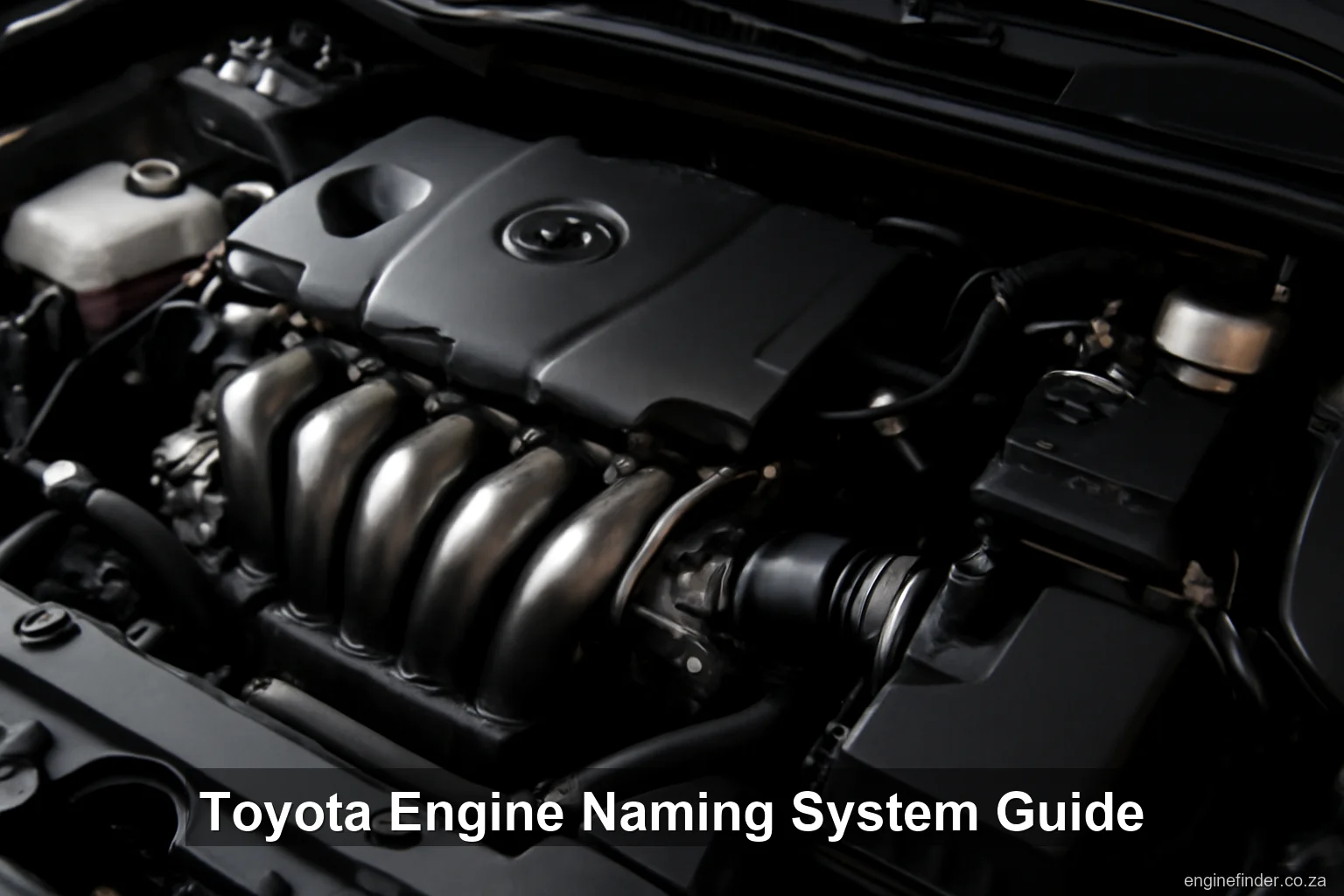
Toyota Engine Naming System Explained: Complete Guide to Engine Codes
Toyota Engine Naming System Explained: Complete Guide to Engine Codes
If you’ve ever wondered what those mysterious letters and numbers on your Toyota engine mean, you’re not alone. Toyota’s engine naming system might seem complex at first glance, but once you understand the logic behind it, these codes become incredibly useful for maintenance, parts sourcing, and performance modifications.
Whether you’re dealing with a legendary 2JZ-GTE from a Supra, a reliable 1KD-FTV from a Hilux, or any other Toyota engine, this comprehensive guide will help you decode every aspect of Toyota’s engine naming convention.
Table of Contents
- Why Toyota Engine Codes Matter
- Toyota Engine Names Explained
- Generation Numbers Explained
- Engine Family Letters
- Feature Suffixes Deep Dive
- Diesel Engine Codes
- Petrol Engine Codes
- Practical Applications
- Common Toyota Engine Families
- South African Market Considerations
Why Toyota Engine Codes Matter
Understanding Toyota’s engine naming system is crucial for several reasons:
Parts Compatibility
Different generations of the same engine family often share components, but subtle differences can affect compatibility. Knowing your exact engine code ensures you order the correct parts every time from Toyota scrap yards or suppliers.
Service Requirements
Each engine generation may have different maintenance schedules, oil specifications, and service procedures. The engine code tells you exactly what your engine needs.
Performance Expectations
The suffix letters reveal important performance characteristics like turbocharging, valve timing systems, and fuel delivery methods.
Resale Value
Some engine codes are more desirable than others. A 2JZ-GTE commands premium prices, while a 1JZ-GTE is also highly sought after for performance applications.
Import/Export Applications
When importing Toyota vehicles or engines into South Africa, understanding the engine code helps determine emissions compliance and parts availability. This is especially important when sourcing engines from international suppliers or when selling cars for scrap.
Toyota Engine Names Explained
Let’s break this down:
- Generation Number: 1, 2, 3, 4, etc. (indicates the engine block generation)
- Family Letters: A, B, E, F, G, JZ, KD, NZ, ZR, etc. (indicates the engine family/design)
- Feature Suffix: After the dash (F, E, GE, GTE, FTV, etc.)
Example: 2JZ-GTE
- 2: Second generation
- JZ: JZ engine family (inline-6 performance engines)
- GTE: Twin cam, Turbo, Electronic fuel injection
Generation Numbers Explained
The generation number indicates the evolution of the engine block design:
First Generation (1)
- 1JZ-GTE: First generation JZ family turbo engine
- 1KD-FTV: First generation KD family diesel
- 1ZZ-FE: First generation ZZ family economy engine
Second Generation (2)
- 2JZ-GTE: Second generation JZ family (larger displacement than 1JZ)
- 2KD-FTV: Second generation KD family diesel
- 2ZZ-GE: Second generation ZZ family performance variant
Third Generation (3)
- 3S-GTE: Third generation S family turbo engine
- 3RZ-FE: Third generation RZ family engine
Fourth Generation (4)
- 4A-GE: Fourth generation A family twin cam
- 4Y: Fourth generation Y family (truck engine)
Each generation typically brings improvements in:
- Fuel efficiency
- Power output
- Emissions compliance
- Reliability
- Manufacturing efficiency
Engine Family Letters
Toyota’s engine families are designated by letters, each representing a specific design philosophy:
Performance Families
JZ Family (Inline-6 Performance)
- 1JZ-GTE: 2.5L inline-6 turbo (Supra, Chaser, Mark II)
- 2JZ-GTE: 3.0L inline-6 turbo (Supra, Aristo)
- 2JZ-GE: 3.0L inline-6 naturally aspirated
S Family (4-cylinder Performance)
- 3S-GTE: 2.0L turbo (Celica All-Trac, MR2)
- 3S-GE: 2.0L naturally aspirated (Celica, MR2)
ZZ Family (Modern 4-cylinder)
- 1ZZ-FE: 1.8L economy (Corolla, Avensis)
- 2ZZ-GE: 1.8L performance (Celica, Corolla T-Sport)
Diesel Families
KD Family (Common Rail Diesel)
- 1KD-FTV: 3.0L turbo diesel (Hilux, Prado, Hiace)
- 2KD-FTV: 2.5L turbo diesel (Hilux, Innova)
VD Family (V8 Diesel)
- 1VD-FTV: 4.5L V8 turbo diesel (Land Cruiser 200)
CD Family (Compact Diesel)
- 1CD-FTV: 2.0L turbo diesel (Avensis, RAV4)
Truck/Commercial Families
TR Family (Truck Engines)
- 1TR-FE: 2.0L petrol (Hilux, Innova)
- 2TR-FE: 2.7L petrol (Hilux, Prado)
GR Family (V6 Engines)
- 1GR-FE: 4.0L V6 petrol (Prado, 4Runner)
Feature Suffixes Deep Dive
The suffix letters after the dash provide crucial information about engine features:
Primary Suffixes
F - Economy Narrow Angle Valve
- Indicates DOHC (Double Overhead Cam) configuration
- Optimized for fuel economy
- Narrow valve angle for compact combustion chamber
- Example: 1ZZ-FE, 2TR-FE
G - Twin Cam Performance
- High-performance DOHC configuration
- Wider valve angles for better airflow
- Typically higher compression ratios
- Example: 4A-GE, 3S-GE
E - Electronic Fuel Injection
- Modern fuel injection system
- Precise fuel delivery
- Better emissions and economy
- Found on most modern engines
T - Turbocharged
- Forced induction system
- Significantly increased power output
- Requires higher octane fuel
- Example: 1JZ-GTE, 3S-GTE
S - Supercharged
- Mechanical forced induction
- Instant power delivery
- Less common than turbo
- Example: 4A-GZE (rare)
Advanced Suffixes
V - Variable Valve Timing
- VVT-i (Variable Valve Timing-intelligent)
- Optimizes valve timing for different RPM ranges
- Improves both power and economy
- Example: 1ZZ-FE (later versions)
D - Direct Injection
- Fuel injected directly into combustion chamber
- Improved fuel economy and power
- D4-D designation for diesels
- Example: 1AD-FTV (D4-D)
Diesel-Specific Suffixes
FTV - Fuel Injection, Turbo, Variable Nozzle Turbo
- Common rail fuel injection
- Turbocharger with variable geometry
- Advanced emissions control
- Example: 1KD-FTV, 2KD-FTV
FTE - Fuel Injection, Turbo, EGR
- Common rail fuel injection
- Turbocharger
- Exhaust Gas Recirculation system
- Example: 1CD-FTE
Diesel Engine Codes
Toyota’s diesel engines are highly regarded for their reliability and efficiency. Here’s a detailed breakdown:
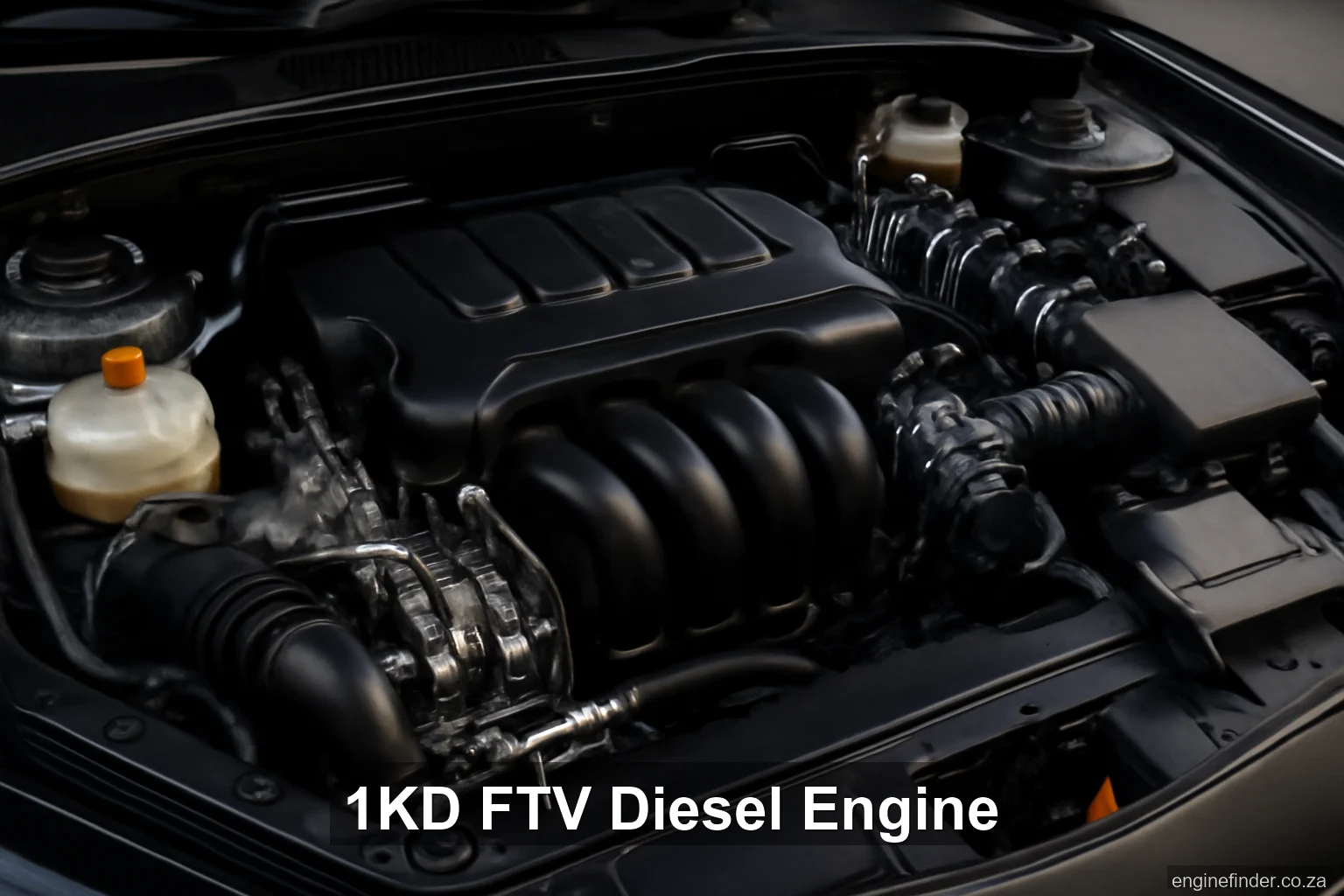 The 1KD-FTV diesel engine - one of Toyota’s most popular and reliable diesel units
The 1KD-FTV diesel engine - one of Toyota’s most popular and reliable diesel units
1KD-FTV (3.0L Turbo Diesel)
- Generation: 1st generation KD family
- Displacement: 3.0L (2,982cc)
- Configuration: Inline-4
- Features: Common rail, turbo, variable nozzle turbo
- Applications: Hilux, Prado, Hiace, Innova
- Power: 126-130kW depending on application
- Torque: 343-420Nm
South African Context: This is one of the most popular diesel engines in SA, powering thousands of Hilux bakkies and Prado SUVs. Parts are readily available from local suppliers, and many workshops specialize in servicing these engines.
2KD-FTV (2.5L Turbo Diesel)
- Generation: 2nd generation KD family
- Displacement: 2.5L (2,494cc)
- Configuration: Inline-4
- Features: Common rail, turbo, variable nozzle turbo
- Applications: Hilux, Innova
- Power: 75-106kW
- Torque: 260-343Nm
Maintenance Note: The 2KD-FTV is known for its fuel efficiency but requires regular DPF (Diesel Particulate Filter) maintenance, especially important in South African driving conditions.
1VD-FTV (4.5L V8 Turbo Diesel)
- Generation: 1st generation VD family
- Displacement: 4.5L (4,461cc)
- Configuration: V8
- Features: Common rail, twin turbo, variable nozzle turbo
- Applications: Land Cruiser 200 Series
- Power: 195-200kW
- Torque: 615-650Nm
Performance Note: This engine is a powerhouse, designed for heavy-duty applications and towing. It’s popular among South African farmers and off-road enthusiasts.
1CD-FTV (2.0L Turbo Diesel)
- Generation: 1st generation CD family
- Displacement: 2.0L (1,995cc)
- Configuration: Inline-4
- Features: Common rail, turbo, variable nozzle turbo
- Applications: Avensis, RAV4 (European/Asian markets)
- Power: 85-93kW
- Torque: 270-310Nm
Import Note: While not officially sold in South Africa, these engines are sometimes found in imported vehicles. Parts availability can be limited.
Petrol Engine Codes
Toyota’s petrol engines range from economy-focused units to high-performance legends:
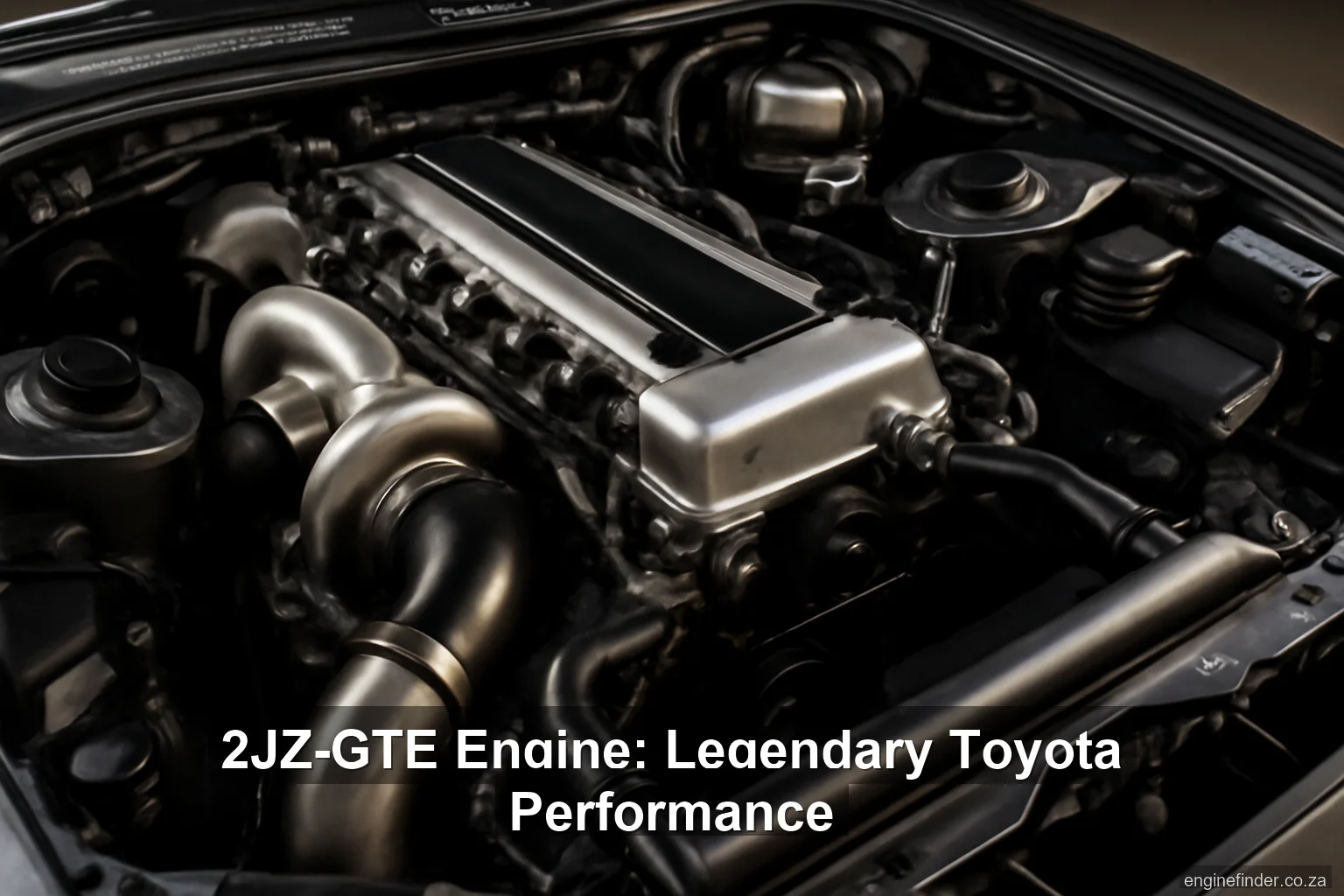 The legendary 2JZ-GTE engine - Toyota’s most famous performance powerplant
The legendary 2JZ-GTE engine - Toyota’s most famous performance powerplant
2JZ-GTE (3.0L Inline-6 Turbo)
- Generation: 2nd generation JZ family
- Displacement: 3.0L (2,997cc)
- Configuration: Inline-6
- Features: DOHC, turbo, electronic fuel injection
- Applications: Supra, Aristo
- Power: 206-243kW (depending on market)
- Torque: 431-441Nm
Legend Status: The 2JZ-GTE is arguably Toyota’s most famous engine, capable of handling massive power increases with modifications. In South Africa, these engines command premium prices due to their performance potential, often rivaling BMW engines in the performance market.
Want to learn everything about this legendary engine? Check out our comprehensive Toyota 2JZ-GTE Engine Guide for detailed technical specifications, tuning potential, performance characteristics, and why it remains the ultimate enthusiast powerplant.
1JZ-GTE (2.5L Inline-6 Turbo)
- Generation: 1st generation JZ family
- Displacement: 2.5L (2,491cc)
- Configuration: Inline-6
- Features: DOHC, turbo, electronic fuel injection
- Applications: Chaser, Mark II, Soarer
- Power: 206kW
- Torque: 353Nm
Tuning Favorite: While smaller than the 2JZ, the 1JZ-GTE is highly regarded for its responsiveness and tuning potential.
4A-GE (1.6L Twin Cam)
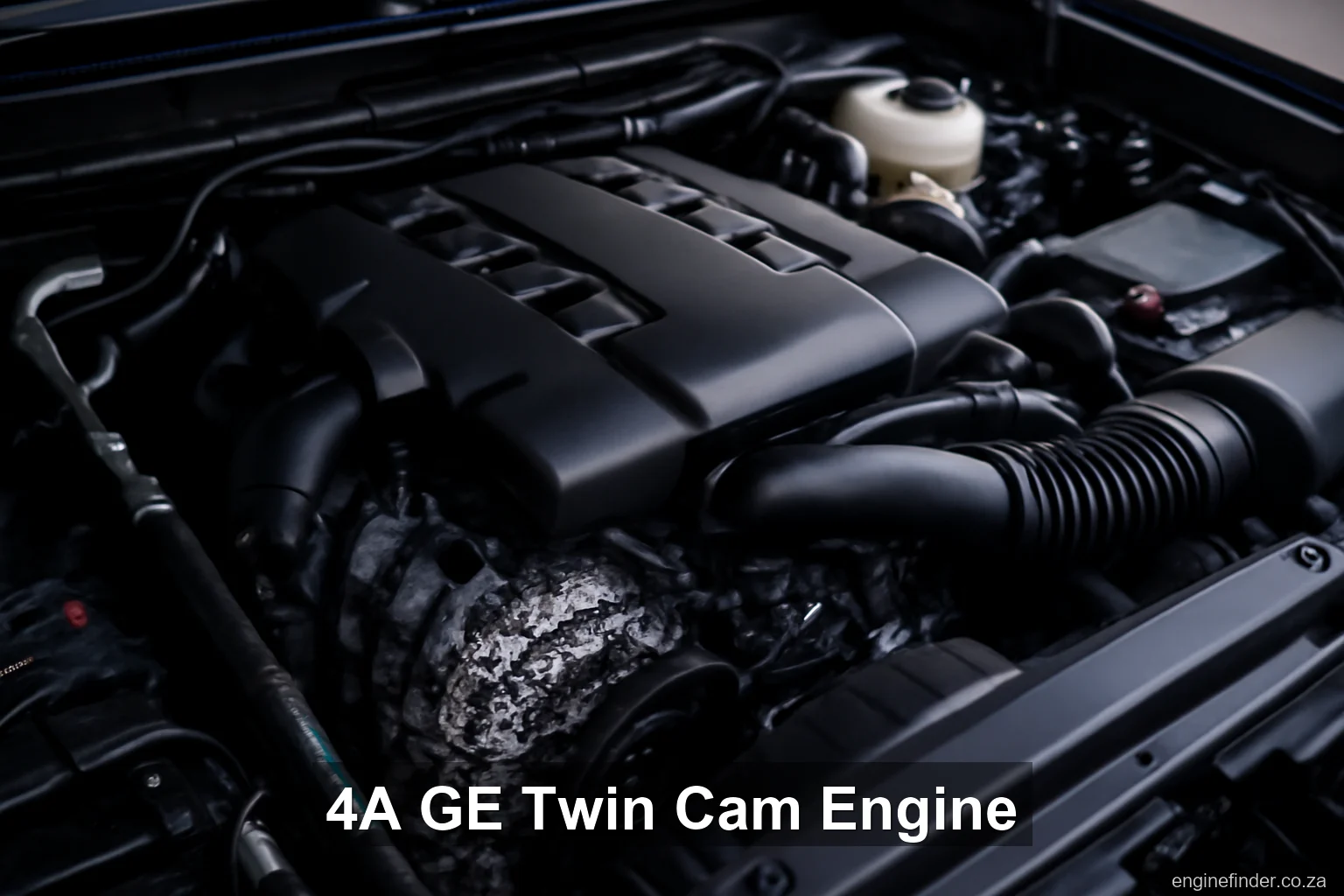 The 4A-GE twin cam engine - beloved by motorsport enthusiasts and drift fans
The 4A-GE twin cam engine - beloved by motorsport enthusiasts and drift fans
- Generation: 4th generation A family
- Displacement: 1.6L (1,587cc)
- Configuration: Inline-4
- Features: DOHC, electronic fuel injection
- Applications: Corolla, AE86
- Power: 85-97kW
- Torque: 148-162Nm
Enthusiast Engine: The 4A-GE, especially in the AE86 Corolla, is beloved by drifting and motorsport enthusiasts worldwide.
2ZZ-GE (1.8L Performance)
- Generation: 2nd generation ZZ family
- Displacement: 1.8L (1,796cc)
- Configuration: Inline-4
- Features: DOHC, VVTL-i (Variable Valve Timing and Lift)
- Applications: Celica, Corolla T-Sport
- Power: 138-141kW
- Torque: 180Nm
High-Rev Hero: The 2ZZ-GE features Toyota’s VVTL-i system, allowing it to rev to 8,200 RPM with a dramatic power increase at 6,200 RPM.
1ZZ-FE (1.8L Economy)
- Generation: 1st generation ZZ family
- Displacement: 1.8L (1,794cc)
- Configuration: Inline-4
- Features: DOHC, electronic fuel injection
- Applications: Corolla, Avensis
- Power: 95-103kW
- Torque: 171Nm
Reliability Champion: The 1ZZ-FE is known for exceptional reliability and fuel economy, making it popular in South African taxi and fleet applications. Its reliability often surpasses many Honda engines in the same category.
Practical Applications
Buying Used Engines
When shopping for a replacement engine from suppliers, the code tells you exactly what you’re getting:
- Compatibility: Ensure the engine code matches your vehicle’s requirements
- Performance: Understand the power and torque characteristics
- Maintenance: Know the service requirements and common issues
- Value: Some codes are more desirable than others
Parts Sourcing
Engine codes help ensure you get the right parts:
- Oil filters: Different generations may use different filter types
- Gaskets: Engine revisions can change gasket requirements
- Sensors: Electronic systems vary between generations
- Injectors: Fuel injection systems differ between codes
Performance Modifications
Understanding engine codes is crucial for modifications:
- Turbo upgrades: Know the engine’s boost handling capabilities
- ECU tuning: Different codes require different tuning approaches
- Internal modifications: Understand the engine’s structural limitations
- Fuel system: Match fuel delivery to engine requirements
Common Toyota Engine Families
Most Reliable
- 1KD-FTV: Diesel workhorse, proven reliability
- 1ZZ-FE: Petrol economy champion
- 2JZ-GE: Naturally aspirated inline-6 reliability
- 1TR-FE: Truck engine built for durability
Most Powerful
- 2JZ-GTE: Legendary turbo inline-6
- 1VD-FTV: V8 diesel powerhouse
- 3S-GTE: Turbo 4-cylinder performance
- 1GR-FE: V6 petrol power comparable to Mercedes-Benz engines
Most Fuel Efficient
- 1ZZ-FE: Excellent economy, often matching Volkswagen engines
- 2KD-FTV: Efficient diesel
- 1TR-FE: Good petrol economy
- 1NZ-FE: Compact car efficiency
Most Tunable
- 2JZ-GTE: Modification legend
- 1JZ-GTE: Tuner favorite
- 3S-GTE: Turbo potential
- 4A-GE: Classic performance
South African Market Considerations
Popular Local Engines
- 1KD-FTV: Hilux and Prado applications
- 2KD-FTV: Hilux and Innova
- 1ZZ-FE: Corolla and Avensis applications
- 2JZ-GTE: Imported Supras and Aristos
Parts Availability
- Excellent: 1KD-FTV, 2KD-FTV, 1ZZ-FE
- Good: 2JZ-GTE, 1JZ-GTE, 4A-GE
- Limited: 1VD-FTV, 2ZZ-GE, 3S-GTE
Service Network
Most Toyota dealers and independent workshops in South Africa are familiar with:
- All KD family diesels
- ZZ family petrol engines
- JZ family engines (due to popularity)
Unlike some Audi engines that require specialized equipment, most Toyota engines can be serviced at general automotive workshops.
Fuel Considerations
- Petrol engines: Most run well on 95 octane
- Turbo engines: Often require 95+ octane
- Diesel engines: Standard diesel fuel quality suitable
Climate Considerations
South Africa’s climate affects engine choice:
- High altitude: Naturally aspirated engines lose power
- Hot climate: Turbo engines need good cooling, particularly important for Ford engines and turbo variants
- Dust: Air filtration crucial for all engines
Decoding Your Engine Code
Where to Find It
- Engine block: Stamped on the engine block
- Chassis plate: On the firewall or door jamb
- Owner’s manual: Listed in specifications
- Parts catalog: When ordering parts
What to Look For
- Complete code: Including all letters and numbers
- Revision letters: Some engines have additional revision codes
- Market designation: Different markets may have variations
Documentation
Keep a record of your engine code for:
- Service history
- Parts ordering from verified suppliers
- Insurance purposes
- Resale value
Conclusion
Understanding Toyota’s engine naming system empowers you to make informed decisions about maintenance, parts sourcing, and performance modifications. Whether you’re running a reliable 1KD-FTV in your Hilux or dreaming of a 2JZ-GTE swap, knowing these codes inside and out will serve you well. This knowledge is also valuable when comparing Toyota engines to Nissan engines or other manufacturers.
The beauty of Toyota’s system lies in its logic and consistency. Once you grasp the pattern, you can decode any Toyota engine and understand its characteristics, capabilities, and requirements.
Quick Reference Guide
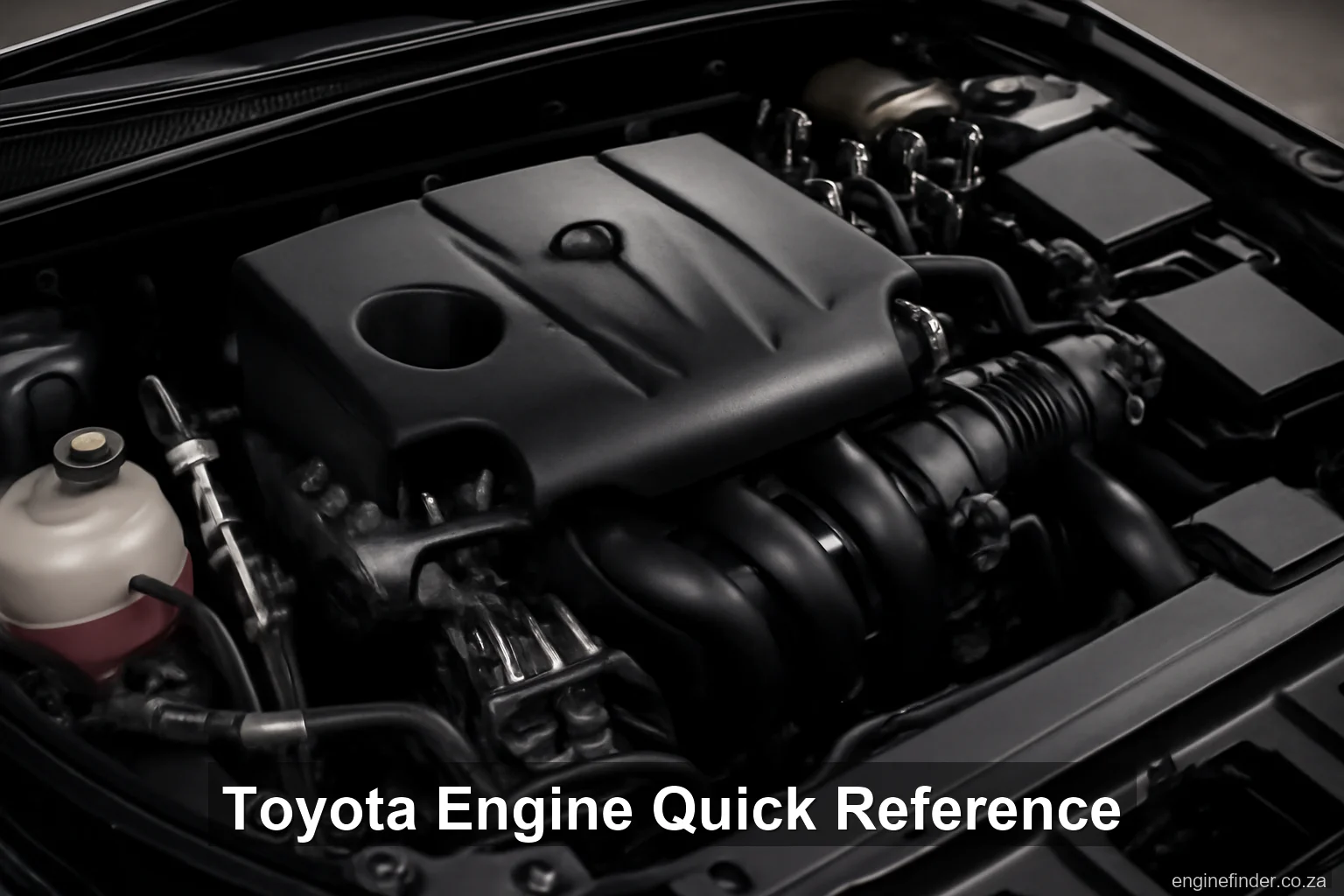 Your complete visual guide to understanding Toyota engine codes
Your complete visual guide to understanding Toyota engine codes
- Generation number: 1, 2, 3, 4 (evolution of the engine family)
- Family letters: JZ, KD, ZZ, S, etc. (engine design family)
- F suffix: Economy DOHC configuration
- G suffix: Performance DOHC configuration
- E suffix: Electronic fuel injection
- T suffix: Turbocharged
- V suffix: Variable valve timing
- FTV suffix: Diesel with common rail and variable nozzle turbo
Further Reading
For those interested in diving deeper into Toyota engine technology and automotive engineering, here are authoritative sources and technical documentation:
Official Documentation & Standards
- List of Toyota Engines - Wikipedia - Comprehensive encyclopedia entry covering all Toyota engine families with detailed technical specifications and naming conventions
- Toyota Model Codes - Wikipedia - Complete guide to Toyota’s vehicle and engine model coding systems from 1937 to present
- Category: Toyota Engines - Wikipedia - Extensive collection of articles on specific Toyota engine families and technical developments
Professional Technical Papers
- Society of Automotive Engineers (SAE) International - Professional technical papers on Toyota engine development:
- Adachi, S., Horio, K., Nakamura, Y., et al. “Development of Toyota 1ZZ-FE Engine,” SAE Technical Paper 981087, 1998. DOI: 10.4271/981087
- Harada, J., Tomita, T., Mizuno, H., et al. “Development of Direct Injection Gasoline Engine,” SAE Technical Paper 970540, 1997. DOI: 10.4271/970540
- Kidokoro, T., Hoshi, K., Hiraku, K., et al. “Development of PZEV Exhaust Emission Control System,” SAE Technical Paper 2003-01-0817, 2003. DOI: 10.4271/2003-01-0817
Technical Service Information
- Toyota Technical Information System (TIS) - Official Toyota service documentation containing detailed engine specifications, repair procedures, and diagnostic information
- Toyota Service Manuals - Model-specific technical documentation with comprehensive engine data and maintenance procedures
Academic & Industry Resources
- Automotive Engineering Textbooks - Standard references covering internal combustion engine design, nomenclature, and performance characteristics
- SAE Standards - Professional engineering standards for automotive engine classification and testing procedures
- International Organization for Standardization (ISO) - Global standards for automotive terminology and engine specifications
Online Technical Communities
- Toyota Technical Forums - Community-driven knowledge bases with real-world experience and technical discussions
- Automotive Engineering Publications - Industry magazines and journals covering Toyota’s latest engine technologies and developments
Looking for Toyota engines or parts in South Africa? Browse our extensive selection of quality engines at competitive prices. Whether you need a replacement 1KD-FTV for your Hilux or a performance 2JZ-GTE for your project, we’ve got you covered with genuine Toyota components and expert advice. Check out our blog for more automotive guides and insights.
Tags: Toyota engines, engine codes, 2JZ-GTE, 1KD-FTV, Toyota parts, South Africa, automotive guide
Related Articles
Explore more insights on similar topics
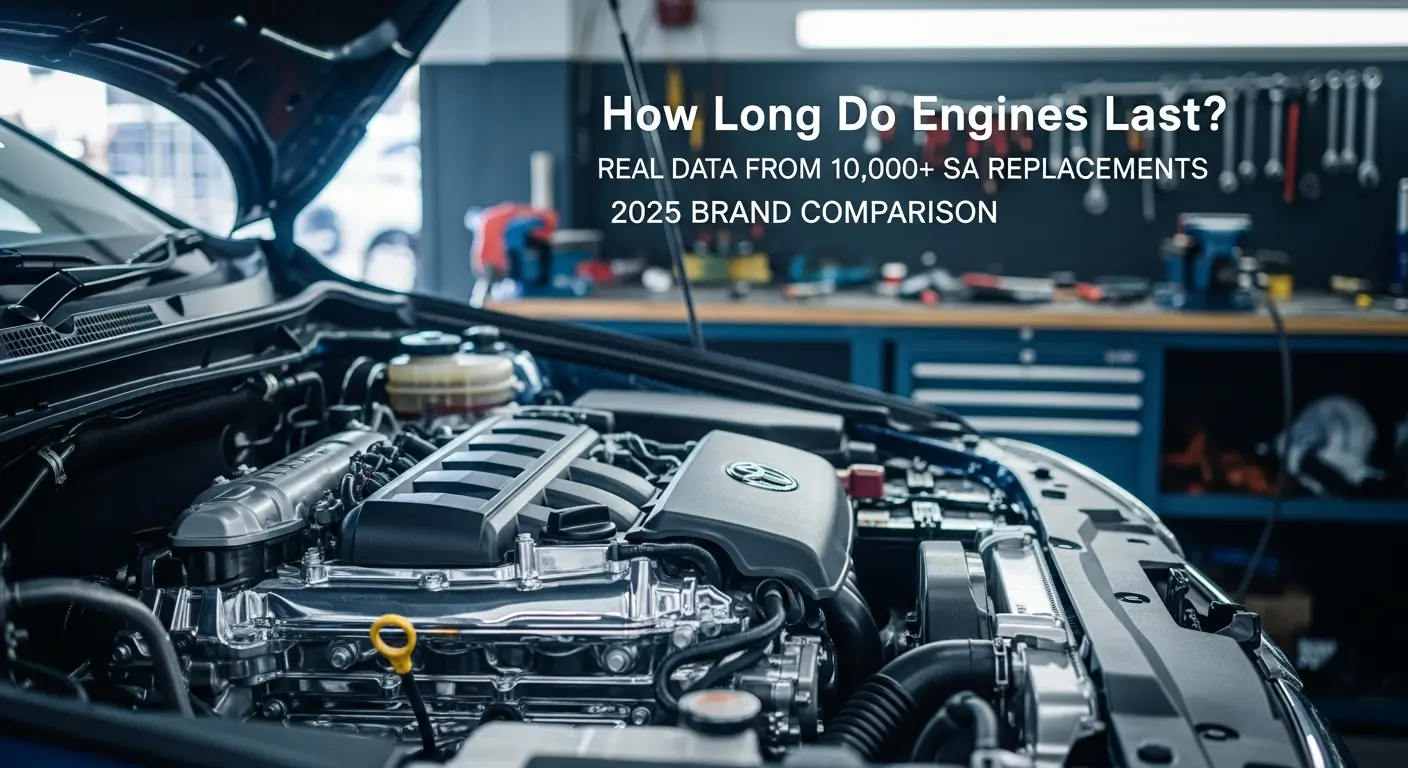
How Long Do Engines Last on Average? Complete Longevity Guide
Understand real-world engine lifespan ranges, warning signs, lifecycle stages, costs, and maintenance best practices for South African drivers.

How Does an Engine Overhaul Work? Complete Guide to Engine Rebuilds
Learn everything about engine overhauls: types, warning signs, process, costs, and when to rebuild vs replace your engine in South Africa.
.webp)
Timing Chain vs Timing Belt: Complete Guide to Cambelt Replacement & Lifespan
Learn everything about timing chains and timing belts (cambelts): differences, lifespans, replacement costs, and which is better for your engine in South Africa.
Important Disclaimer
This content is for informational purposes only and is based on research from automotive industry sources. Engine Finder is not a certified automotive repair facility. Always consult with qualified automotive professionals before performing any repairs or maintenance. Improper repairs can result in personal injury, property damage, or vehicle malfunction. We assume no responsibility for actions taken based on this information.
